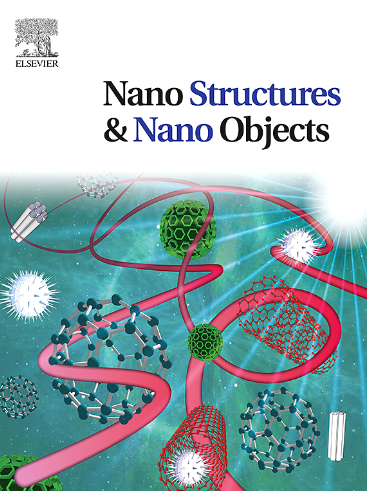Enhanced hydrogen evolution activity and magnetic/electrodynamic properties of Fe/Bi co-doped nano CoNiV spinel oxides
IF 5.45
Q1 Physics and Astronomy
引用次数: 0
Abstract
In this study, Fe/Bi co-doped CoNiV nano spinel oxides (Co0.5Ni0.5FexBixV2–2xO4 (x ≤ 0.040) NSOs) were synthesized through a hydrothermal approach. Employing M-H curves at 300 K (Room temperature, RT) and 10 K, magnetic properties of Fe/Bi doped CoNiV (x ≤ 0.040) NSOs are examined. It is observed that they possess paramagnetic and superparamagnetic nature at RT and 10 K, respectively. Substitution of V atoms with Fe/Bi yields fluctuations of magnetic parameters (with a maximum at x = 0.030) with growing doping content at 10 K. The accompanying saturation magnetization (Ms) at 10 K is estimated through the Langevin function, giving rise to the highest (lowest) Ms value at x = 0.030 (0.000, undoped NSOs). Our findings demonstrate that magnetic characteristics of Fe/Bi doped CoNiV (x ≤ 0.040) NSOs can be adjusted by controlling Fe/Bi dopants. The electrocatalyst Fe/Bi doped CoNiV (x = 0.04)@CS nanoelectrocatalyst demonstrated notable performance in the HER, with an overpotential of 271 mV, a Tafel slope of 131.07 mV/dec, and remarkable stability up to 20 h using chronopotentiometry methods. The surface and electrochemical analyses demonstrated that the sample, which underwent dual doping with 4.0 % Fe+3 and 4.0 % Bi+3 concentrations, had enhanced performance in the HER. Additionally, electromagnetic studies revealed superior EMI shielding effectiveness (SET), with the x = 0.03 composition achieving ∼30 dB over a broad frequency range. These results establish Fe/Bi doping as an effective strategy to tailor structural, magnetic, electrochemical, and EMI shielding properties, highlighting its multifunctional potential.
求助全文
约1分钟内获得全文
求助全文
来源期刊

Nano-Structures & Nano-Objects
Physics and Astronomy-Condensed Matter Physics
CiteScore
9.20
自引率
0.00%
发文量
60
审稿时长
22 days
期刊介绍:
Nano-Structures & Nano-Objects is a new journal devoted to all aspects of the synthesis and the properties of this new flourishing domain. The journal is devoted to novel architectures at the nano-level with an emphasis on new synthesis and characterization methods. The journal is focused on the objects rather than on their applications. However, the research for new applications of original nano-structures & nano-objects in various fields such as nano-electronics, energy conversion, catalysis, drug delivery and nano-medicine is also welcome. The scope of Nano-Structures & Nano-Objects involves: -Metal and alloy nanoparticles with complex nanostructures such as shape control, core-shell and dumbells -Oxide nanoparticles and nanostructures, with complex oxide/metal, oxide/surface and oxide /organic interfaces -Inorganic semi-conducting nanoparticles (quantum dots) with an emphasis on new phases, structures, shapes and complexity -Nanostructures involving molecular inorganic species such as nanoparticles of coordination compounds, molecular magnets, spin transition nanoparticles etc. or organic nano-objects, in particular for molecular electronics -Nanostructured materials such as nano-MOFs and nano-zeolites -Hetero-junctions between molecules and nano-objects, between different nano-objects & nanostructures or between nano-objects & nanostructures and surfaces -Methods of characterization specific of the nano size or adapted for the nano size such as X-ray and neutron scattering, light scattering, NMR, Raman, Plasmonics, near field microscopies, various TEM and SEM techniques, magnetic studies, etc .
 求助内容:
求助内容: 应助结果提醒方式:
应助结果提醒方式:


